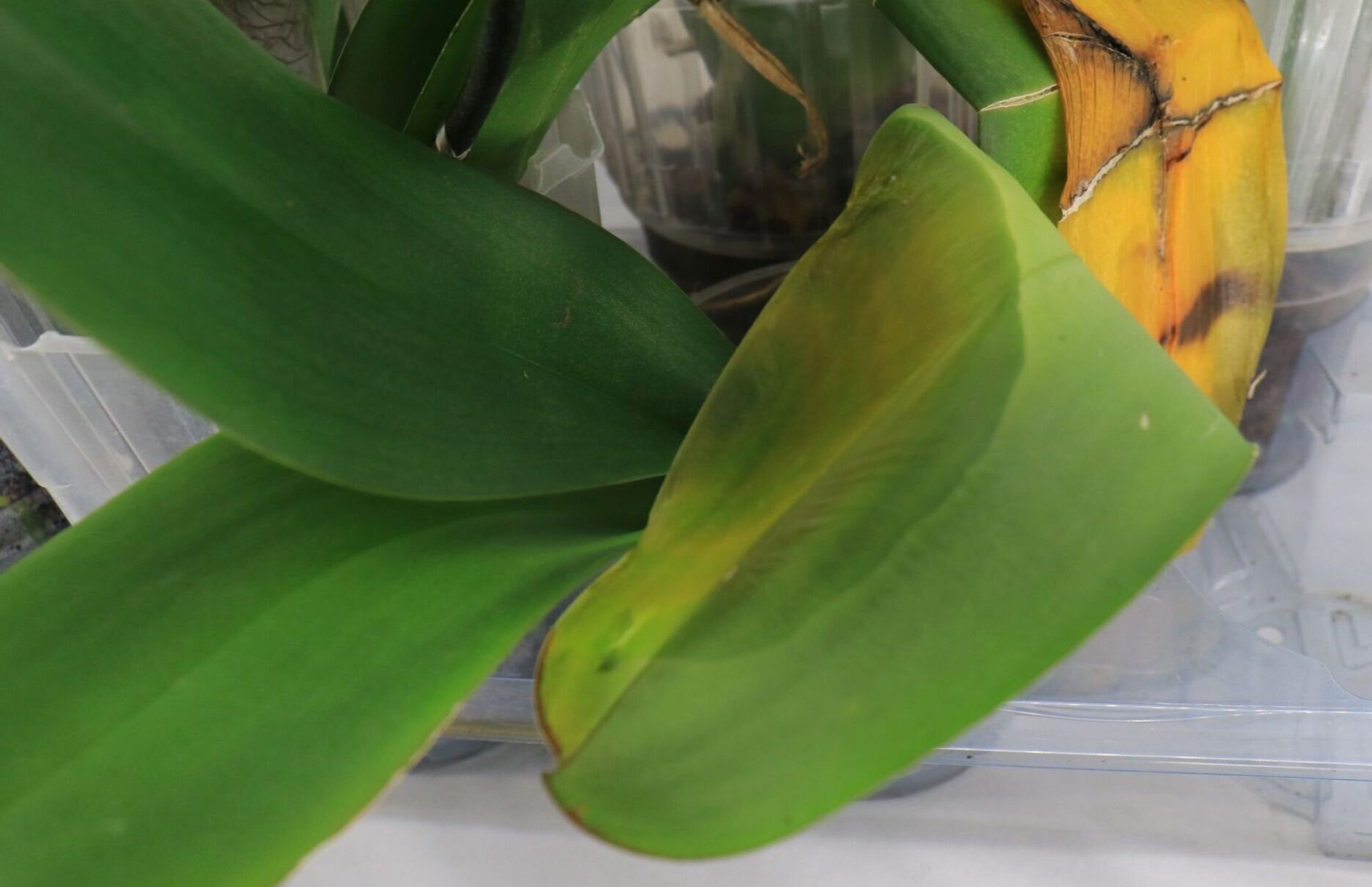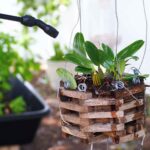Your orchid was flourishing, but it’s starting to look a little sick. “Why are my orchid’s leaves turning yellow?” you ask. Here are a few potential causes of the yellowing leaves on your orchid and what you can do to fix them.
Because dying roots are unable to transport nutrients or water around the orchid, orchid leaves turn yellow, indicating stress from overwatering or drought. Temperatures below 55°F and sunburn can also cause orchids to turn yellow.
Let’s look at all of the reasons why your orchid’s leaves are turning yellow and what you can do to fix the issue. Yellowed and wrinkled leaves of an orchid can be a sign of illness, the result of mistakes made during the process of leaving at home, or a completely natural process.
Further Reading: Are Orchids Toxic to Cats, Dogs or Other Pets
- Common Reasons for Orchid Leaves Turning Yellow
- The Natural Death of Old Foliage on the Plant
- Too Much Direct Sunlight
- High Or Low Temperature
- Overwatering of Your Plant
- Under-Watering of Your Plant
- Seasonal Changes
- A Sudden Change in the Environment
- Too Much Fertilizer
- A Nutrient Deficiency
- Exposure to Hard Water Or Chemicals
- Fungal and Bacterial Infections
- Potting Stress
- Remedies of Orchid Leaves Turning Yellow
- Conclusion: Finding the Reason for the Yellowing
Common Reasons for Orchid Leaves Turning Yellow
The top ten reasons for orchid leaf yellowing are listed below, along with advice on how to identify the issue before it compromises the health of the leaf.
The Natural Death of Old Foliage on the Plant
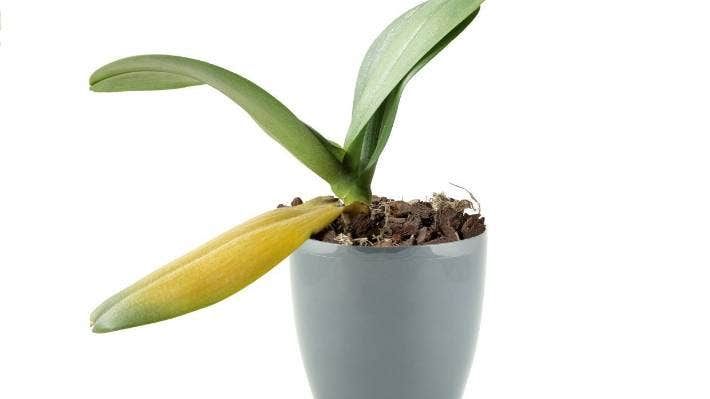
Yellowing leaves on orchids are typically a normal part of this particular plant’s life cycle. The lowest set of leaves begins to turn yellow when the plant needs to produce new leaves or a new flower spike. They eventually regress and detach from the plant.
Orchids prioritize new growth, so the plant considers the lower leaves superfluous, which is why it does this. The leaves access to water is cut off, and as a result, they eventually wither and fall off the plant.
Too Much Direct Sunlight
In the wild, orchids are tropical plants that typically thrive in shade from trees. Since they are not accustomed to direct sunlight, the leaves may turn yellow if they are placed in an area that receives excessive amounts of it.
Although all plants require light, orchids prefer indirect sunlight.
Yellowing leaves and fading are signs that there is too much direct sunlight. Additionally, you might notice burnt leaf tips, leaf cracks, and scorch marks. When choosing a location for your orchid plant, keep this in mind.
High Or Low Temperature
The majority of tropical indoor plants and flowers are more sensitive to air temperature than orchids are. Leaves can turn yellow even after a short period of time with temperatures that are too high or low. Indoor orchids should always maintain a temperature above 60 degrees Fahrenheit unless you are raising orchids grown outdoors or with known hardiness.
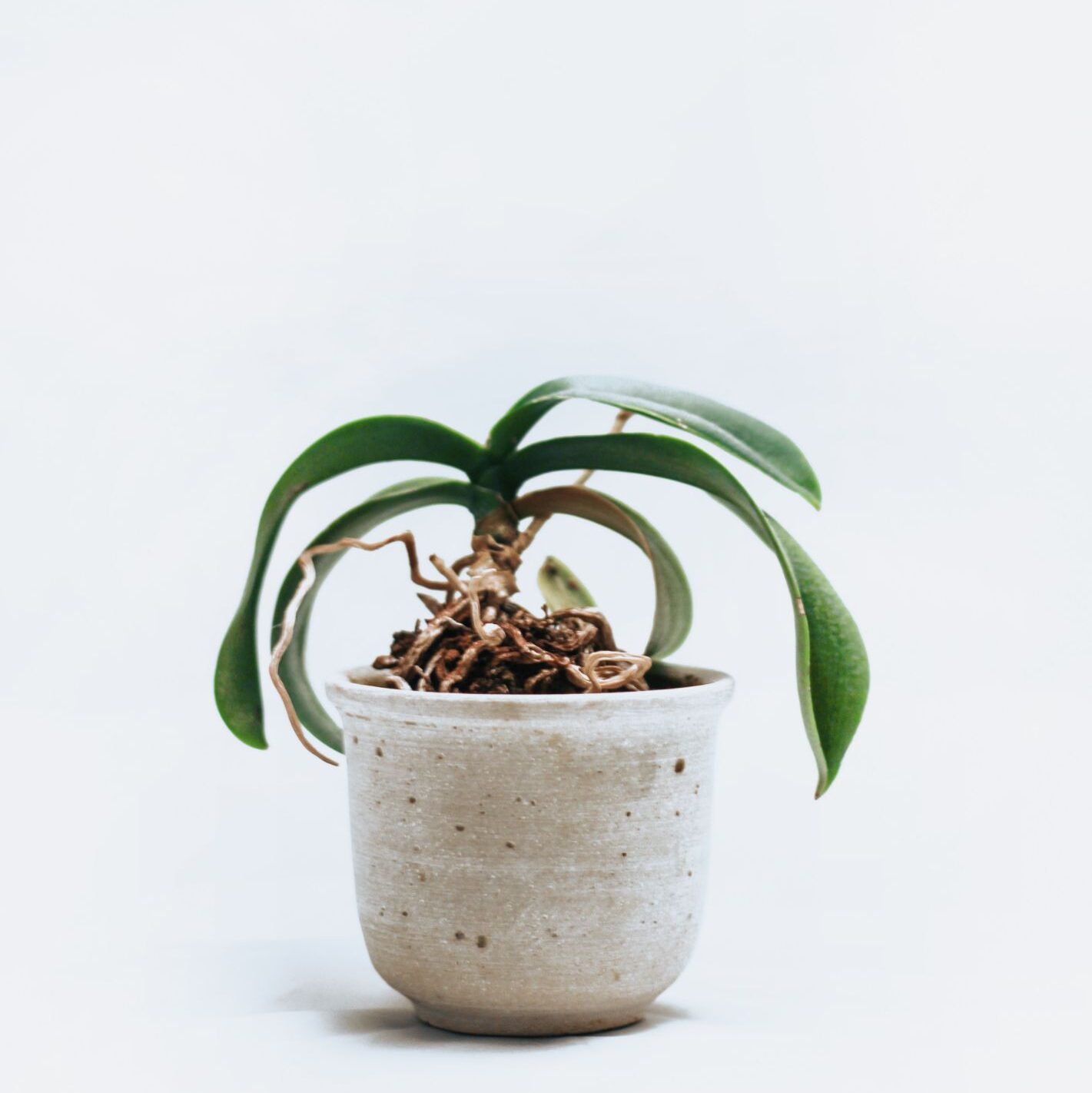
Yellowing and other stress-related symptoms can easily be caused by brief dips below this level. For the majority of common orchid species, avoid temperatures above 75 to 80 degrees F, especially in enclosed spaces where humidity can fluctuate. Particularly orchids that prefer cool temperatures, like Odontoglossum, Cymbidium, and Dendrobium
Overwatering of Your Plant
Too much water can even cause root rot, which results in the death of the roots and causes the orchid leaves to turn yellow. It is impossible for the plant to absorb water and nutrients from the soil if there is too much water in the container. This can develop into a serious issue, as you might expect.
Under-Watering of Your Plant
You’ll notice soft and yellowing leaves if you fail to water your orchid when it needs it. They’ll wilt and dry out, and the stem as a whole could wilt or soften. Don’t give up on your orchid if it loses most or all of its leaves before recovering from being submerged because it won’t recover right away.
To prevent the plant from losing the majority of its water into the air during a re-watering phase, make sure the humidity level remains constant and high.
Seasonal Changes
Seasonal changes are hard on the plants because there are dozens of common reasons why an orchid will yellow. Temperature, humidity, light, and other factors naturally change as the seasons change. A slight yellowing caused by the change shouldn’t last too long if the proper conditions can be restored.
A Sudden Change in the Environment
A plant may experience stress when its location or environment is changed, which can result in the loss of leaves or blooms.
Greater stress in plants is indicated by yellowing leaves. When you first bring your plant home from the store or when you move it from one room to another, you might experience this stress. It might occur if you have to move houses or for any other reason.
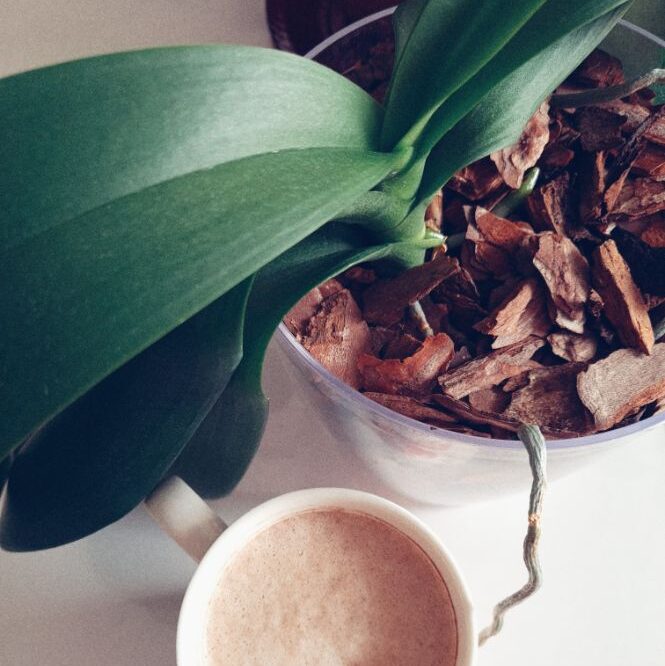
Too Much Fertilizer
It’s simple to add too much fertilizer, just like when you overwater your plants. Calcium, manganese, copper, and zinc are among the extra nutrients that can end up in the soil when you add too much fertilizer.
Although the plants do require additional nutrients, the levels can become too high, which prevents your orchids from absorbing iron.
Yellowing of the leaves is a symptom of iron deficiency in orchids. Chlorosis is the name of the illness. You want your plant to be healthy, but you may not be aware that adding too much can be just as problematic as adding insufficiently.
A Nutrient Deficiency
A nutrient deficiency could also result in yellowing if you don’t fertilize your plants. If you believe that your plant will receive enough nutrients from the potting soil, you might be unaware that you need to fertilize your plants.
Despite the fact that it does, there isn’t enough to last forever. If you don’t apply a feeding, your plant will begin to exhibit signs of nutrient deficiency once the reserves of nutrients are depleted.
Manganese, zinc, iron, and nitrogen deficiencies are most frequently found in orchids. Every one of these needs fertilizer to grow properly.
Exposure to Hard Water Or Chemicals
The type of tap water you use to feed and water your plants is one issue that these plants don’t always manage well.
Water that has been overly chlorine treated or that is hard in some areas. In these situations, your orchid plants might have trouble processing these chemicals, which could result in yellowing tips.
The ability of the plant to absorb vital micronutrients can be harmed by hard water’s high levels of calcium and magnesium. This may result in nutritional deficiencies and leaf issues.
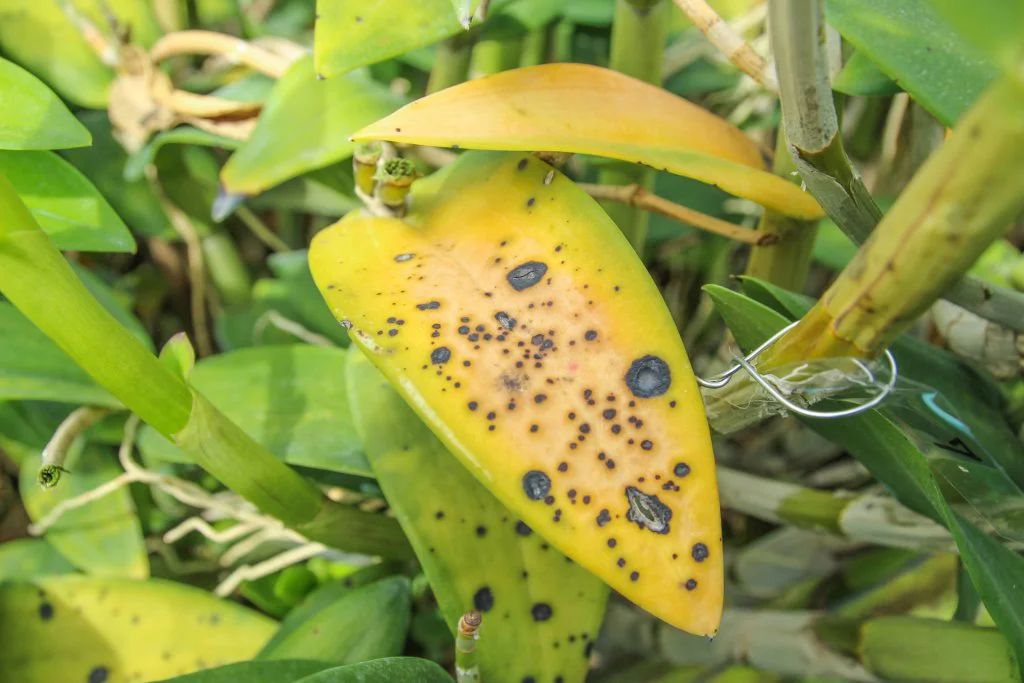
Fungal and Bacterial Infections
The orchid is vulnerable to fungus and bacteria due to changes in humidity and temperature. When there are fungal spores present, high humidity and temperatures can be especially harmful. Infected leaves by fungi and bacteria typically turn yellow from the tip or across the entire surface.
If the fungus is destroying the roots in the soil, you might not notice it. Switching to a new sterile planting medium and letting the plant dry out from overwatering are two options. Yellowing leaves cannot be saved by surface infections, but the spread can be stopped.
Potting Stress
The most frequent causes of yellowing orchid leaves after repotting are transplant shock or planting in too-wet potting media. The presence of yellow leaves indicates stress brought on by temperature changes, humidity fluctuations, air currents, light levels, or an excess of moisture around the roots.
Repotting or moving your orchid may result in a change in the environment that is incompatible with its ideal surroundings.
Correcting the stressful environmental factors is necessary to save it.
In order to allow oxygen to circulate around the roots for root respiration, orchid roots need to be replanted once every two to three years. Pine bark chippings make the best potting soil for orchids because of their pore-filled design, which encourages good drainage and protects the roots.
If you’ve replanted your orchid in moss or potting soil, these materials retain too much moisture around the roots and rob them of oxygen, which leads to the yellowing of the leaves and the eventual death of the orchid.
Further Reading: How To Treat Black Spots On Orchid Leaves?
Remedies of Orchid Leaves Turning Yellow
Examine the roots first if you notice yellowing orchid leaves. Examine the roots and stem of the plant after gently removing it from the pot. Change your watering schedule if the roots are white, gray, or black.
Healthy roots suggest that problems with nutrients, temperature, or humidity are the cause of the yellowing. Change the surroundings of the plant and give it a few weeks to heal. A recovery enclosure that is simple to maintain at the ideal temperature and humidity may be something you want to build. After letting an orchid dry out or become overly wet, you can use this to help it recover.
Conclusion: Finding the Reason for the Yellowing
Go through each of these nine causes in order to identify the issue when you notice your orchid’s leaves turning yellow. Your plant may be stressed, or it may be going through its natural life cycle.
Once you’ve identified the cause of the yellowing, you can address the issue and make sure it doesn’t come back in the future by taking the necessary actions.
Most importantly, if you notice yellowing, don’t freak out. An orchid will experience more stress than benefit if you attempt too many fixes at once. Before making any adjustments, take your time figuring out the cause.
Please share this article with your friends if it was helpful to you.

